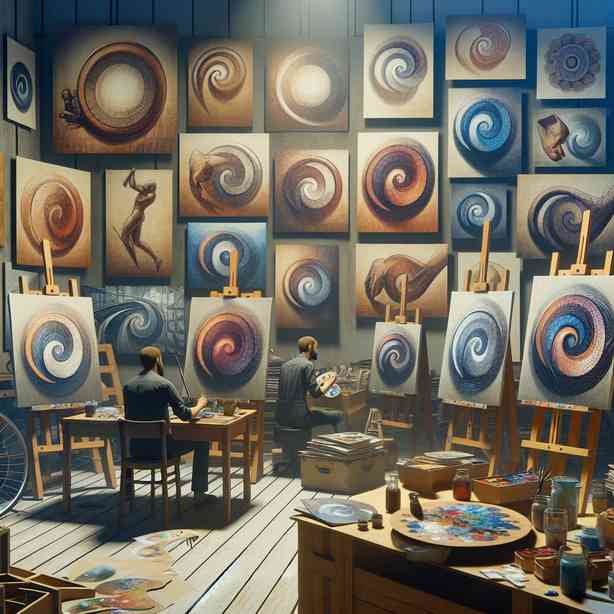
When you repaint the same subject over and over, it may seem repetitive at first glance, but this practice opens a world of artistic exploration and personal growth. Many renowned artists have engaged in this technique, finding beauty and significance in the subtleties of the same scene or figure. Through the lens of repetition, one can delve into the nuances of color, form, light, and emotion, ultimately achieving a deeper understanding of their own artistic voice and the subject they are portraying.
At its core, revisiting the same subject cultivates a unique relationship between the artist and the artwork. Each painting becomes a new exploration, where the artist can experiment with different techniques, styles, and perspectives. Consider the works of Claude Monet, who painted the water lilies in his garden at Giverny multiple times. Each iteration captures different light conditions, seasonal changes, and personal emotions that influenced his brushwork. This journey into repetition allows artists to observe and appreciate aspects of their subject that might be overlooked in a one-time representation.
Additionally, the act of painting the same subject repeatedly encourages a mindfulness that can be transformative. It leads to greater awareness of the details that comprise the whole. You may notice how the interplay of light creates intricate shadows, or how the colors blend and shift when viewed from different angles. This meticulous attention to detail can enhance your skills as an artist, allowing you to push boundaries and experiment with your approach in a safe space.
Engaging with the same composition also enables the exploration of emotion in art. As you revisit a subject, the feelings you associate with it may change and evolve, infusing each subsequent work with new layers of meaning. For instance, a landscape that once evoked serenity might later stir up feelings of nostalgia or longing, depending on your experiences over time. By translating these emotional shifts onto the canvas, your art becomes a mirror of both personal and universal human experiences.
Moreover, repeating the same subject allows for the exploration of different mediums. You may choose to paint, draw, or even create sculptures based on the same inspiration. Trying various techniques—oil painting, watercolor, digital art—can lead to surprising discoveries about both the medium and the subject itself. These variations not only broaden your skill set but can also illuminate aspects of your subject that might be more challenging to express through a single medium.
From a technical standpoint, painting the same subject repeatedly provides an invaluable opportunity for growth and refinement. Each iteration tests your skills and allows you to fine-tune your techniques. You might find yourself mastering a particular brushstroke or developing a new signature style that only emerges through commitment and practice. This dedication can significantly enhance your confidence and capability as an artist.
The community aspect of engaging with repetitive subjects also holds importance. Sharing your journey with fellow artists and receiving feedback can catalyze your growth and inspire fresh ideas. Whether through online platforms, workshops, or local art classes, connecting with others who understand the intricacies of the creative process can bring new insights, critiques, and camaraderie. Engaging in conversations about your works can provide new perspectives and motivate you to continue pushing the limits of your artistic expression.
As you embark on this journey of repainting the same subject, it’s essential to maintain a mindset of curiosity and exploration. Instead of viewing repetition as a constraint, approach it as an opportunity. Consider ways to present the subject differently—altering your viewpoint, experimenting with abstract interpretations, or even incorporating mixed media elements can breathe new life into familiar themes. Invite spontaneity into your practice, allowing yourself to break free from rigid expectations and embrace unexpected outcomes.
Ultimately, the process of repainting the same subject reveals the dynamic nature of art and its ability to communicate complex emotions and ideas. Each piece becomes a testament to your evolving relationship with the subject matter and a reflection of your growth as an artist. Embracing the cyclical nature of this process encourages an atmosphere of continuous discovery and learning.
In conclusion, repainting the same subject opens doors to new artistic dimensions and personal insights. It fosters technical skill, emotional exploration, and a deepening of one’s artistic voice. Engaging thoughtfully with repetition can lead to transformative experiences, enriching your creative journey. As you continue to explore the dimensions of familiarity and newness through this practice, you may find not only a greater appreciation for your subject but also a profound connection to your artistic self. Inviting this practice into your routine can truly redefine your approach to art and living a creative life. Remember, the heart of creativity often lies in the journey, not merely the destination. Let your brush dance with the subject, and discover the magic that unfolds with each stroke.


